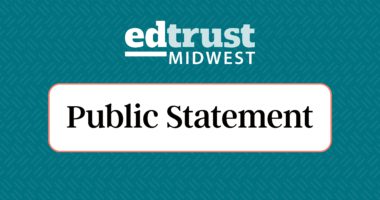Bridge Michigan Opinion | Michigan’s school finance system limits vulnerable students’ prospects
All of Michigan’s children deserve an equal opportunity to succeed. Today they don’t have one — but that can change.
A new report prepared by national funding experts for The Education Trust-Midwest shows Michigan’s school finance system limits opportunity for children from low-income and rural communities and other vulnerable student groups, reducing their chances for good paying jobs after graduation and preventing the growth of the state’s talent pool that is vital to the state’s economic growth. The report is being released today.
The report’s key takeaway: Michigan needs to invest much more in all of its students statewide, while investing significantly more in the students who need it the most. If done right, a revamped state school funding system presents the opportunity to begin to address decades of historic inequities harmful to vulnerable students across the state — and to the state’s economy overall.
As The Education Trust-Midwest has shown, Michigan trails many other states for not only educational performance but also for improvement. As a leader in the statewide campaign to make Michigan a top ten education state for all students, our organization has advocated for state leaders to improve key research-based levers for improving Michigan’s public education system, from investing more in educator effectiveness to evidence-based strategies to dramatically boost third-grading reading levels.
Never before, though, has our organization focused so deeply on funding as we do in this new report, for good reason: Money alone is insufficient for educational transformation. Yet money matters, especially for vulnerable students. Increases in education spending have been shown to improve educational attainment, lead to higher wages and reduce poverty in adulthood, particularly for students from low-income backgrounds.
As a data-driven, research-based organization, we follow the data. And a growing body of evidence show Michigan is facing a real crisis for equitable school funding. Michigan ranks in the bottom five states nationally for funding gaps between states’ high-poverty and affluent school districts. Indeed, Michigan is one of only 16 states providing less funding to its highest-poverty districts than to its lowest-poverty districts. The Education Law Center gives Michigan a “D” for how well it targets funding to high-poverty districts, relative to low-poverty districts.
With this report, we are joining other organizations across Michigan who are calling for moving the state’s funding system to a weighted student funding formula, through which the state would invest much more in vulnerable students: students with disabilities, isolated rural students, students from low-income families and English learners.
Just as we have pointed to leading education states for lessons for Michigan to learn from about improving accountability for K-12 education performance and better practices, in this report we also highlight states who are leading in equitable school funding. Massachusetts, for example, has led the U.S. for educational performance and best practices for much of the last two decades. Today, its leaders have set an ambitious but realistic goal of becoming a top educational performer in the world –not just for their rich children but for all of their students.
To do just that, last year Massachusetts passed legislation to overhaul its funding system over the next seven years. Under its new system, state leaders will invest up to 100 percent more dollars in low-income students than non-low-income students – nearing what national research suggests is needed to close gaps in opportunity and achievement.
Like all of our state’s students, Michigan’s rural students, students from low-income backgrounds, students with disabilities and English learners deserve the best public schools that America can offer –and surely deserve as good of public schools as leading education states provide.
To make that goal happen – and to become a top 10 education state for all students – our report provides funding principles and recommendations based on both national research findings and leading states’ work including:
- Provide funding according to student need. Michigan is lagging behind the nation in how it invests in many different groups of vulnerable students. Today, for example, students from low-income backgrounds in Michigan receive an additional 11 percent, compared to Massachusetts’ plan of up to 100 percent more. Michigan should follow in Massachusetts’ footsteps and invest at least 100 percent more, implementing over several years as other states have done.
- Provide more funding to districts with lower fiscal capacity. Our report recommends the state provide sufficient funding to low-wealth districts to fully make up the difference between what the district needs and what it is reasonably able to contribute based on property wealth and income. That includes additional support for geographically isolated rural districts.
- Ensure that dollars are used well to improve student learning experiences and outcomes.
Michigan needs not only to invest more, but also do a much better job of informing the public about the systems design and monitoring the funding going to districts, as well as designing and implementing improved systems of accountability and transparency for school funding.
Michigan’s funding system is falling short for all students, especially Michigan’s most vulnerable children. Let’s follow the example of successful states, where student achievement is better overall and a zip code doesn’t limit opportunity – thanks in part to education funding focused on opportunity for all.
________________________________________________________________
Guest commentary by Amber Arellano, executive director of The Education Trust-Midwest as appeared in Bridge Michigan.




